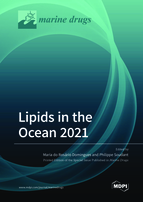Lipids in the Ocean 2021
A special issue of Marine Drugs (ISSN 1660-3397).
Deadline for manuscript submissions: closed (20 December 2021) | Viewed by 33048
Special Issue Editors
Interests: lipidomics; oxidized lipids; nitrated/nitroxidized lipids; protein lipoxidation; Mass spectrometry; LC-MS
Special Issues, Collections and Topics in MDPI journals
Special Issue Information
Dear Colleagues,
Lipids represent the major constituents of marine organisms, as major players in biological membranes, with key roles in biological processes and acclimation to environmental changes. New research trends aim to contribute to a better knowledge of lipids’ role in the biological matrix, to understand the impact of climate change in marine organisms, and to develop new tools for chemophenotyping, traceability, biomarkers of trophic chains in marine ecosystems, and to disclose the nutritional value or prospective bioactive compounds for health applications.
“Lipids in the Ocean 2021” (http://lipids2021.web.ua.pt), which will be held at the University of Aveiro, from 5 to 7 July 2021 (due to uncertainties regarding the Covid-19 situation, it will be an Online Conference), aiming to go in deep into these research interests covering topics related with lipids from marine organisms, such as marine lipidomics, lipids as biomarkers in trophic webs, green lipids from the ocean (seaweeds, microalgae, and macrophytes), marine lipid biotechnology, and seafood traceability using lipids, from basic research to sustainable production and applications in the food, nutraceutics, feed, cosmetics, and pharma industries.
This Special Issue welcomes not only attendees of “Lipids in the Ocean 2021” to publish their latest research outcomes, but also all researchers in relevant fields to share their exciting works with the community.
Prof. Dr. Rosário Domingues
Dr. Philippe Soudant
Guest Editors
Manuscript Submission Information
Manuscripts should be submitted online at www.mdpi.com by registering and logging in to this website. Once you are registered, click here to go to the submission form. Manuscripts can be submitted until the deadline. All submissions that pass pre-check are peer-reviewed. Accepted papers will be published continuously in the journal (as soon as accepted) and will be listed together on the special issue website. Research articles, review articles as well as short communications are invited. For planned papers, a title and short abstract (about 100 words) can be sent to the Editorial Office for announcement on this website.
Submitted manuscripts should not have been published previously, nor be under consideration for publication elsewhere (except conference proceedings papers). All manuscripts are thoroughly refereed through a single-blind peer-review process. A guide for authors and other relevant information for submission of manuscripts is available on the Instructions for Authors page. Marine Drugs is an international peer-reviewed open access monthly journal published by MDPI.
Please visit the Instructions for Authors page before submitting a manuscript. The Article Processing Charge (APC) for publication in this open access journal is 2900 CHF (Swiss Francs). Submitted papers should be well formatted and use good English. Authors may use MDPI's English editing service prior to publication or during author revisions.







